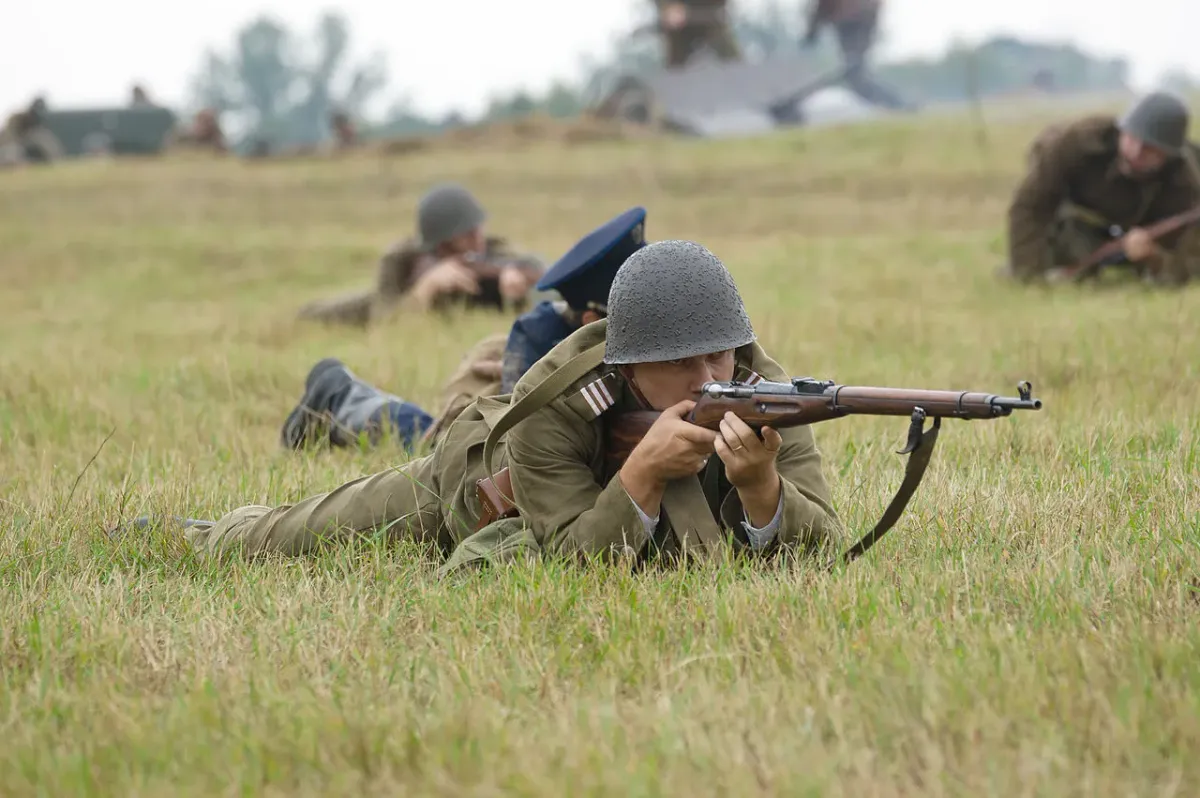The Rising Use of Mosin Rifles in Ukraine: What It Means for Russian Military Strategy and Its Historical Significance

TL;DR
Russian forces in Ukraine are increasingly using Mosin-Nagant rifles, a 19th-century bolt-action firearm, reflecting logistical constraints and material shortages within the Russian military. Known for its durability and long-range accuracy, the Mosin has seen renewed use among reservists and conscripts, though it lacks the tactical effectiveness of modern rifles. This development highlights Russia’s resource limitations and recalls similar use of Mosins in the Syrian Civil War. While symbolic of Russian resilience, the Mosin’s resurgence also underscores the challenges facing Moscow in sustaining its campaign in Ukraine.
Introduction: The Resurgence of the Mosin-Nagant
In the ongoing conflict in Ukraine, reports have surfaced that Russian forces, including newly conscripted soldiers and irregular units, are increasingly deploying with Mosin-Nagant rifles—a bolt-action firearm that dates back to the late 19th century. This historic weapon, which saw extensive use in World Wars I and II, has unexpectedly reappeared on modern battlefields in Ukraine. While surprising, this development reveals significant insights into Russia’s logistical struggles, strategic choices, and reliance on unconventional tactics as its military resources are stretched.
The presence of Mosin rifles among Russian forces has raised questions about both their effectiveness in modern combat and the broader state of Russia’s military capabilities. Moreover, the Mosin has been employed in previous conflicts, including the Syrian Civil War, offering insight into Russia's continued use of older firearms when circumstances demand.
The Mosin-Nagant: A Snapshot of History
The Mosin-Nagant, officially known as the 3-line rifle M1891, was developed in Imperial Russia and entered service in 1891. Chambered in 7.62×54mmR, it is one of the most mass-produced bolt-action rifles in history, with over 37 million units manufactured. Its rugged design and powerful cartridge allowed it to serve as the primary rifle of Russian and later Soviet forces through the early 20th century.
Despite its age, the Mosin-Nagant has a reputation for reliability under harsh conditions, including extreme cold and rugged terrain. It was particularly favored for its durability and range, characteristics that led to the development of sniper variants, like the Mosin-Nagant M91/30, which excelled as a marksman’s weapon during WWII. However, with advancements in firearms technology, it has long been surpassed by semi-automatic and automatic rifles, making its resurgence on the Ukrainian battlefield both unusual and symbolic.
Why Are Mosins Appearing in Ukraine?
Several factors contribute to the Mosin's reappearance among Russian forces in Ukraine:
- Resource Constraints: Russia's military has been expending large amounts of munitions and modern firearms, resulting in shortages. As a result, older weapons like the Mosin are being issued to reservists, conscripts, and auxiliary forces such as those in the Donbas region.
- Unconventional Warfare: The Mosin’s long-range accuracy makes it useful in certain roles, particularly for snipers or designated marksmen. In areas where engagements occur over long distances, such as the fields and urban environments of eastern Ukraine, a well-placed Mosin can still be effective, despite its limitations.
- Symbolic and Psychological Factors: The Mosin-Nagant carries symbolic value for Russian forces, embodying historical resilience. In some respects, issuing this weapon reflects a form of psychological warfare, evoking Russia's extensive military history and perseverance against past adversaries.
The Psychological and Propaganda Dimensions
Beyond tactical considerations, the deployment of Mosin-Nagant rifles carries psychological and propaganda value. Domestically, the Kremlin may portray the weapon as a symbol of Russian endurance and historical pride. The Mosin evokes memories of Soviet victories during WWII, an era central to Russia’s national identity. By framing the rifle’s use as a nod to Russia’s storied military past, Moscow may aim to bolster morale among its citizens and rank-and-file soldiers alike.
However, this narrative has its risks. Internationally, the Mosin’s appearance invites scrutiny and ridicule, with Western analysts and media often interpreting it as a symbol of desperation. Within the conflict, Ukrainian forces may exploit this imagery to strengthen their narrative of resilience and superiority. Videos and images of Russian soldiers wielding 19th-century rifles juxtaposed with modern Ukrainian equipment serve as potent morale boosters for Ukraine and its allies.
Tactical Use and Limitations of the Mosin in Ukraine
While reliable, the Mosin faces considerable drawbacks on a modern battlefield:
- Rate of Fire: As a bolt-action rifle, the Mosin lacks the rapid fire capabilities of modern assault rifles. This limitation can be a significant disadvantage in close combat, where higher rates of fire are crucial.
- Ammunition Compatibility: The Mosin-Nagant fires a 7.62×54mmR cartridge, which is also used by some Russian machine guns, but the logistical burden of managing ammunition for a small number of Mosins among predominantly automatic firearms complicates supply lines.
- Aging Components: Given their age, Mosin rifles may face reliability issues under intense, prolonged use. Decades of storage can lead to wear and degradation in essential parts, making them less dependable than modern rifles.
However, despite these limitations, the Mosin’s powerful cartridge and accuracy at range mean it can still function effectively in niche roles, such as sniping from fixed positions or providing cover fire over long distances. Russian units lacking advanced gear may position Mosin-armed soldiers as marksmen in defensive setups, reinforcing their lines where other resources are scarce.
Technological Disparity: A Tale of Two Arsenals
The Mosin’s resurgence also serves to highlight the technological disparity between the warring parties. Ukrainian forces, bolstered by Western aid, have received advanced NATO-standard weapons such as the M4 carbine, FN SCAR, and precision sniper rifles like the Barrett M82. These modern systems outperform the Mosin in nearly every aspect, from fire rate to ergonomic design. This contrast does more than symbolize the uneven resource backing; it shapes the dynamics of combat engagements.
Ukrainian soldiers equipped with superior optics, suppressors, and thermal imaging can exploit the limitations of Mosin-armed adversaries, especially in night operations or rapid assaults. Conversely, Russian units with Mosins must adapt by relying on fortified positions or ambush tactics, which further reflects a strategic shift toward defensive posturing in certain regions of Ukraine.
The Mosin’s Role in the Syrian Conflict
The Mosin-Nagant previously saw combat in the Syrian Civil War, where it was employed by both government forces and various militia groups. In Syria, the Mosin served primarily in urban combat and was often used as a sniper rifle, capitalizing on its range and accuracy. Its role in Syria highlights its continued relevance in asymmetric warfare environments, where long-range firepower can offer strategic advantages without necessitating modern, high-cost weaponry.
The Syrian conflict demonstrated the Mosin's utility for forces that lack access to newer firearms. Russia’s use of Mosins in Syria was seen as a pragmatic choice, allowing Moscow to arm allied forces without depleting its stocks of modern firearms. This approach has seemingly been adapted for use in Ukraine, where Russia faces similar logistical constraints.
A Historical Parallel: Lessons from Other Conflicts
The reappearance of the Mosin-Nagant rifle in the Ukrainian conflict is not unprecedented in modern warfare. Historical examples underscore how states under resource strain have leaned on older military assets. During the later stages of World War II, as Nazi Germany faced significant logistical shortages, it reintroduced older rifles like the Karabiner 98k into service alongside the Volkssturm militia. Similarly, in the Iran-Iraq War (1980–1988), older bolt-action rifles were used in reserve roles when modern weapon supplies dwindled. These precedents highlight a recurring theme: nations facing protracted conflict and resource scarcity often revert to utilitarian solutions that favor reliability and availability over cutting-edge effectiveness.
The use of Mosins during the Syrian Civil War offers further insight. In Syria, both government forces and militias utilized these rifles primarily in static defensive roles. The weapon’s long-range capabilities and the slow pace of engagements in urban or semi-urban combat made the Mosin a pragmatic choice for forces lacking modern sniper rifles. Russia’s experience in Syria likely informed its approach in Ukraine, particularly in assigning Mosins to similar roles where firepower and rate of fire are less critical than precision and resilience.
What the Use of Mosin Rifles Signals About Russia’s Military
The return of the Mosin to active use suggests underlying challenges within Russia’s armed forces. Moscow’s decision to reissue Mosins points to several critical issues:
- Strain on Military Resources: Prolonged engagements and heavy losses in Ukraine have stressed Russia’s supply chains and its ability to equip new recruits with modern weapons. Older weapons, including Mosins and WWII-era PPS-43 submachine guns, have become fallback options in the face of extensive materiel losses.
- Reliance on Reservists and Conscripts: Reports indicate that Russia is mobilizing older reservists and inexperienced conscripts, some as old as 60, to fill gaps in personnel. Many of these conscripts are issued outdated weaponry, such as the Mosin, likely because modern firearms are prioritized for front-line or elite units. This signals a resource-limited approach to maintaining combat capability, even if it means sacrificing tactical effectiveness.
- Public Sentiment and Symbolism: The decision to deploy Mosins may also reflect an attempt by the Kremlin to appeal to Russian nationalism by showcasing a weapon deeply embedded in Russian military lore. This symbolic gesture may be aimed at rallying domestic support by evoking historical pride, though its practical impact is minimal.
Broader Implications of Outdated Weapons in Modern Conflict
The resurgence of the Mosin-Nagant highlights the resourcefulness, but also the desperation, of Russian forces. It underscores the asymmetry of the conflict, with Ukraine receiving modern weapons from Western allies while Russian forces, particularly those in auxiliary and conscripted units, rely on antiquated equipment.
The deployment of Mosins may also influence Ukrainian morale, as it showcases the material disparity between Ukrainian and Russian forces. Ukrainian soldiers, often armed with NATO-standard rifles, see the Mosin as emblematic of Russian deficiencies and logistical struggles.
The Broader Strategic Picture
Russia’s reliance on Mosin rifles also raises questions about its long-term military strategy. Prolonged conflicts require sustained logistics, and the integration of outdated equipment suggests that Russia’s supply chains are increasingly stretched. While this might be a stopgap solution, it signals broader systemic issues, from production bottlenecks in modern firearms to challenges in mobilizing an adequately equipped reserve force.
Moreover, the Mosin’s deployment highlights a potential shift in Russia’s strategic focus. If the conflict continues to escalate, Moscow may prioritize regions where precision, rather than volume of fire, plays a decisive role. The use of Mosins in entrenched positions or sniper roles reflects an attempt to maximize the utility of available resources, even if it means sacrificing overall combat effectiveness in offensive operations.
Conclusion: A Symbol of Strain and Resilience
The increasing presence of Mosin rifles among Russian forces in Ukraine serves as both a symbol of resilience and a stark indicator of resource strain. As Russia’s military grapples with supply shortages and logistical limitations, it turns to relics of the past, merging history with the realities of modern warfare. While the Mosin has proven its worth in certain roles, its reissue in 2024 underscores the challenges facing Russia’s campaign and the extent to which Moscow must stretch its resources to sustain prolonged conflict.
The Mosin-Nagant rifle’s return to the battlefield underscores the cyclical nature of military adaptation during prolonged conflicts. Its storied history, enduring reliability, and symbolic weight contrast sharply with the modern, tech-driven warfare seen elsewhere in Ukraine. As this conflict evolves, the Mosin stands as both a relic of the past and a testament to the enduring challenges of resource management in war. Its presence reminds us that even as technology advances, the constraints of logistics and the imperatives of strategy often bring history full circle. The Mosin-Nagant, once a stalwart of Russian military might, now represents the compromises and adjustments Moscow must make in a war that shows no signs of abating.
